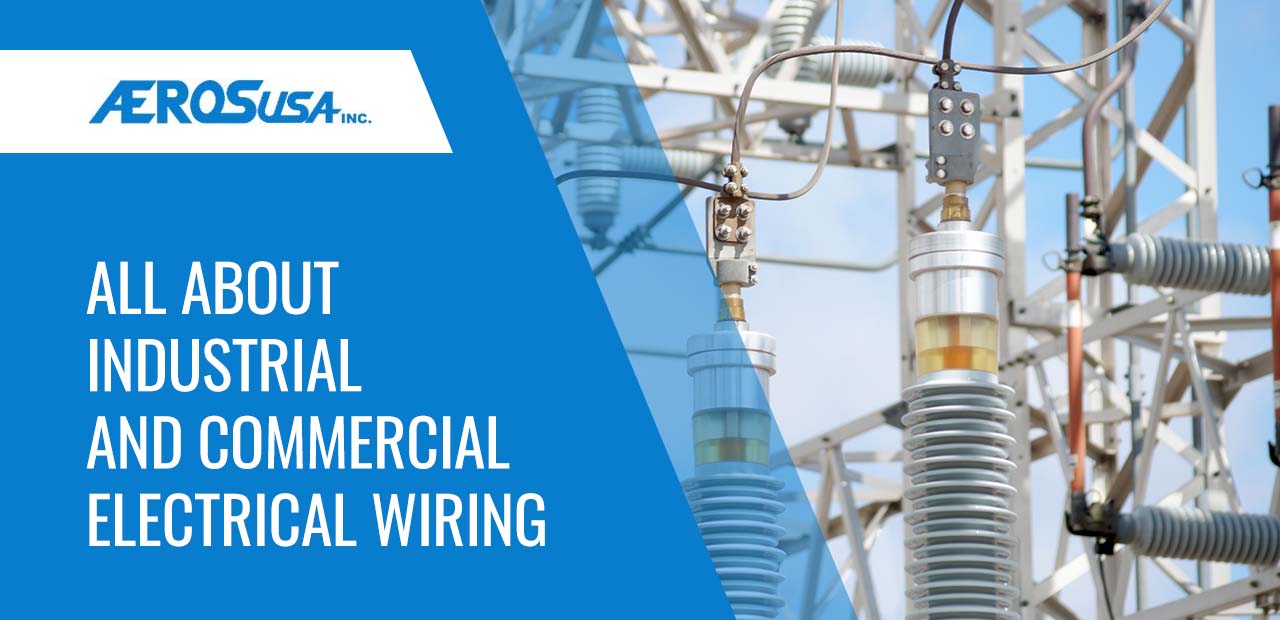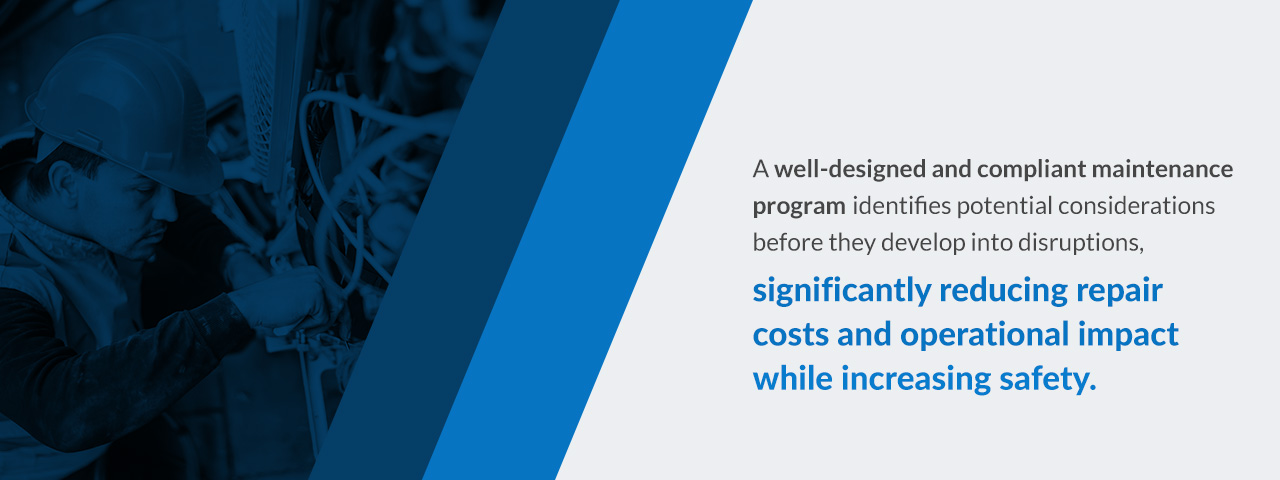
Industrial and commercial electrical systems are crucial fixtures in buildings everywhere. These systems differ significantly from residential wiring due to their increased complexity and power demands. Industrial and commercial systems need to support diverse loads that include HVAC equipment, specialized machinery and sophisticated IT infrastructure.
Understanding these systems is essential for anyone working in or managing industrial or commercial facilities.
Table of Contents
Power Distribution Differences: Commercial vs. Residential Electrical Wiring
Residential and commercial electrical wiring vary in power distribution, particularly when it comes to configuration, scale and material selection. While homes typically use single-phase 120/240V service, commercial buildings can implement 208V three-phase distribution to effectively support larger loads.
Commercial installations typically require more robust protection, including metal-clad cable for improved durability and fire resistance, rigid conduit or electrical metallic tubing (EMT) providing superior physical protection and firestop systems at wall and floor penetrations. The initial investment in premium materials typically returns significant value through extended service life and reduced maintenance requirements.
Common Wiring Methods in Commercial Buildings
Commercial electric wiring employs several distinct methods, each offering specific advantages for different applications within the same facility. Understanding commercial electrical wiring requirements lets designers choose the best approaches for various building areas based on installation requirements, future flexibility needs and budget considerations.
1. Conduit and Raceway Systems
Conduit-based wiring systems represent the most common approach in commercial construction, offering superior protection and excellent future adaptability. EMT provides a cost-effective solution for general applications, with thin-wall steel construction offering good physical protection while remaining relatively easy to install. For more demanding environments, rigid metal conduit offers maximum protection for industrial electrical wiring, but at higher material and labor costs.
2. Cable Tray Systems
Cable tray systems offer an increasingly popular alternative to conduit in many commercial applications, especially where frequent reconfiguration might be necessary. These open support structures accommodate multiple cables without the labor-intensive pulling operations required for conduit systems.
Modern designs include solid bottom, ventilated, ladder and wire mesh configurations, each optimized for different environmental and support requirements. The open design facilitates heat dissipation, particularly valuable for large conductor installations where ambient temperatures might otherwise limit ampacity.
3. Armored and Metal-Clad Cable
Metal-clad and armored cables provide intermediate solutions between conduit systems and open cable installation. These factory-assembled cable assemblies include current-carrying conductors, an equipment grounding conductor and metal armor providing physical protection and simplified grounding. Armored cable includes an internal bonding strip in continuous contact with the armor.
Both types are often used in commercial construction, particularly for branch circuits where future modification seems unlikely.
4. Busway and Busduct Systems
For high current distribution in industrial and large commercial facilities, busway systems provide compact, flexible power delivery options. The modular design allows reconfiguration as loads change, while the factory assembly provides consistent quality that’s difficult to maintain with field-fabricated connections. The primary considerations include higher initial costs and limited routing flexibility compared to cable-based systems.
Maintenance Tips for Commercial Electrical Wiring Safety
Proactive commercial electrical wiring maintenance is invaluable in preventing operational interruptions and extending system lifespan. A well-designed and compliant maintenance program identifies potential considerations before they develop into disruptions, significantly reducing repair costs and operational impact while increasing safety.

Effective maintenance begins with establishing a comprehensive inspection schedule addressing different system components at appropriate intervals. The right schedule balances thoroughness with practical resource constraints while ensuring all potential issues get an appropriate level of attention. Consider these important inspection tasks:
- Monthly visual inspections for warning signs such as discoloration, unusual odors or buzzing.
- Quarterly thermographic scanning to identify hot spots in distribution equipment.
- Semi-annual review of system performance and energy consumption patterns.
- Annual comprehensive inspection with connection torque verification.
- Bi-annual code compliance review and documentation updates.
These scheduled activities help identify developing situations before they cause a significant impact. The combination of regular visual assessments and technical measurements creates a monitoring system to capture both obvious and subtle changes in the condition of a system.
Is Panel Cleaning Important?
Panel cleanliness directly impacts safety and reliability in commercial electrical systems. Dust accumulation on circuit breakers and bus bars creates potential tracking paths for electrical current, particularly in humanoid environments. This situation can eventually create conditions with potential consequences. Regular cleaning using appropriate methods and equipment helps maintain the proper operation of protective devices while allowing visual inspection of components not otherwise visible.
How Maintenance Documentation Should Be Managed
Comprehensive documentation is essential for effective electrical maintenance programs. Without proper records, even the most diligent maintenance efforts lose their value as historical context disappears and knowledge becomes fragmented.
Effective documentation systems capture current system configurations and maintenance history, providing key reference material for troubleshooting and future modifications while demonstrating regulatory compliance. Maintenance documents should include the following information:
- Updated single-line diagrams showing overall system architecture.
- Current panel schedules with circuit identification and load data.
- Detailed maintenance records documenting all service activities.
- Equipment specifications and manufacturer recommendations.
- Training records for maintenance personnel and system operators.
- Digital maintenance management systems for automated tracking.
- Historical performance data identifying system trends.
Modern facilities increasingly implement digital maintenance management systems that track scheduled services and maintain historical performance data. These systems generate automatic work orders, verify completion and provide analytical tools identifying trends across equipment types or facility areas. This systematic approach takes basic maintenance from reactive repairs to proactive management, which significantly improves reliability and safety.
Why Reliable Cable Protection Is Essential
Proper cable protection ensures long-term system reliability in demanding industrial and commercial applications. Protecting conductors from environmental and mechanical stresses significantly extends the service life while reducing maintenance requirements.
Electrical systems face numerous environmental factors that can compromise performance. Identifying these challenges early allows for appropriate protection strategies. Potential issues include:
- Moisture exposure affecting insulation integrity.
- UV radiation deteriorating outdoor installations.
- Extreme temperatures accelerating material aging.
- Chemical exposure degrading protective coverings.
- Particulate contamination creating tracking paths.
Physical protection prevents many common electrical failures in active environments. Proper mechanical safeguards prevent damage from impacts, movement and operational stresses:
- Impact-resistant conduit systems in high-traffic areas.
- Abrasion-resistant coverings where movement occurs.
- Appropriate bend radius control, preventing conductor stress.
- Strain relief at all termination points.
- Vibration isolation for equipment connections.
What Makes Good Protection System Design?
Effective cable protection integrates multiple strategies addressing specific environmental and mechanical challenges. The best cable protection systems balance performance, accessibility and cost. Prioritize complete environmental sealing appropriate to the location. It is also important to select materials based on exposure conditions and maintain flexibility to accommodate operational movement. Standardized connection systems maintain integrity and allow for future expansion.
How Does Material Selection Impact Performance Protections?
Modern protection materials offer specialized properties for different applications. Selecting the right materials impacts system longevity and maintenance requirements.
Choose chemical-resistant compounds for harsh environments and UV-stabilized formulations for outdoor exposure. Flame-retardant options are essential for fire-safety requirements. Overall, lightweight designs can reduce installation costs, and flexibility is important for dynamic applications.
Find Quality Electric Cable and Wire Protection From AerosUSA

Industrial and commercial wiring demands specialized knowledge, quality materials and ongoing attention to ensure safe, reliable operation. By implementing appropriate protection measures, facility managers can significantly enhance reliability and create safer work environments.
For specialized cable protection solutions designed specifically for demanding industrial and commercial applications, contact AerosUSA today. Our comprehensive range of conduit systems, connectors and accessories provides unsurpassed protection across numerous industries, including renewable energy, robotics, transportation and manufacturing.
Browse our range of available products, and learn more about how we can support your needs.

